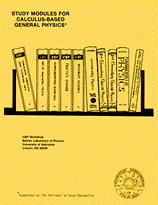Instructional Materials in Physics and Astronomy
Date of this Version
1975
Abstract
If you have ever watched or played pool, football, baseball, soccer, hockey, or been involved in an automobile accident you have some idea about the results of a collision. We are interested in studying collisions for a variety of reasons. For example, you can determine the speed of a bullet by making use of the physics of the collision process. You can also estimate the speed of an automobile before the accident by knowing the physics of the collision process and a few other physical principles. Physicists use collisions to determine the properties of atomic and subatomic particles. Essentially, a particle accelerator is a device that provides a controlled collision process between subatomic particles so that, among other things, some of the properties of the target particle can be studied.
In addition the study of collisions is an example of the use of a fundamental physical tool, i.e., a conservation law. A conservation law implies that something remains the same, i.e., is conserved, as you have seen in a previous module, Conservation of Energy.
Conservation laws play an important role in physics. In the study of collisions in this module we are interested in one of the fundamental conservation laws, conservation of linear momentum. If the sum of the external forces is zero, then the linear momentum is conserved in the collision. This is fortunate since it provides a way around the analysis of the forces of interaction between two bodies as they collide, an otherwise formidable task. Thus the conservation-of-linear-momentum law allows one to analyze the effects of a collision without a detailed knowledge of the forces of interaction. One can deduce the converse also, as does the particle physicist in accelerator experiments, for example - some of the properties of the target particles may be deduced from the law of conservation of linear momentum and other laws of physics.



Comments
From Study Modules for Calculus-Based General Physics
Copyright © 1975 CBP Workshop, University of Nebraska–Lincoln.
Reproduction rights granted.